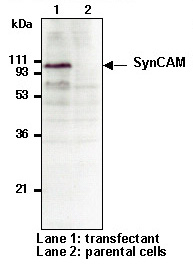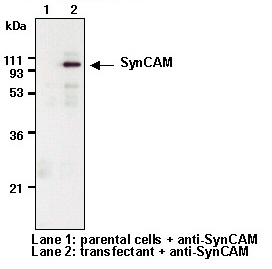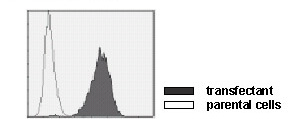This site is for customers in Asia.
Customers in China & other regions, please go to Global page.
HOME >
Product search results > Code No. CM004-3
Anti-SynCAM (TSLC1/CADM1) mAb
Availability (in Japan)
10 or more
(In Japan at 00:05,
Apr 19, 2024 in JST)
Size
100 µL (1 mg/mL)
| Data | |||||
|---|---|---|---|---|---|
| Clonality | Monoclonal | Clone | 3E1 | ||
| Isotype (Immunized Animal) | Chicken IgY | ||||
| Applications | |||||
| Immunogen (Antigen) | Recombinant SynCAM-Fc fusion protein | ||||
| Reactivity [Gene ID] | Human[23705], Mouse*[54725](PMID: 19435791/23741316/24753442), Rat*[363058](PMID: 27756895), Horse*[100062374](PMID: 27524460), Porcine*[106504882](PMID: 28890720) |
||||
| Storage buffer | PBS/50% glycerol, pH 7.2 | ||||
| Storage temp. | -20°C | Conjugate | Unlabeled | Manufacturer | MBL |
| Alternative names | cell adhesion molecule 1, BL2, IGSF4, IGSF4A, NECL2, Necl-2, RA175, ST17, sTSLC-1, sgIGSF | ||||
| Background | SynCAM (Synaptic Cell Adhesion Molecule), also known as TSLC1 (tumor suppressor in lung cancer-1), SgIGSF, or CADM1, is a homophilic, transmembrane Ig-domain containing protein with intracellular PDZ protein-binding motifs. Although originally identified as a tumor suppressor of small lung cell carcinomas, SynCAM appears to be primarily involved in intracellular adhesion and synapse formation. The majority of SynCAM is localized to synaptic sites where it initiates synaptic assembly and synapse differentiation throughout the central nervous system. SynCAM also mediates the cellular adhesion of spermatogenic cells to Sertoli cells and mast cells to fibroblasts. | ||||
| Related products | CM005-3 Anti-SynCAM (TSLC1/CADM1) (Human) mAb PM084 Normal Chicken IgY PM084-4 Normal Chicken IgY-FITC PM084-5 Normal Chicken IgY-PE CM004-4 Anti-SynCAM (TSLC1/CADM1) mAb-FITC CM004-5 Anti-SynCAM (TSLC1/CADM1) mAb-PE CM004-6 Anti-SynCAM (TSLC1/CADM1) mAb-Biotin CM004-A64 Anti-SynCAM (TSLC1/CADM1) mAb-Alexa Fluor™ 647 |
||||
| Citations |
Western Blotting
Immunoprecipitation
Flow Cytometry
Immunocytochemistry
Immunohistochemistry
ELISA
|
||||
| Product category |
|
||||
- The availability is based on the information in Japan at 00:05, Apr 19, 2024 in JST.
- The special price is shown in red color.
- Please note that products cannot be ordered from this website. To purchase the items listed in this website, please contact us or local distributers.
- Abbreviations for applications:
WB: Western Blotting, IH: Immunohistochemistry, IC: Immunocytochemistry, IP: Immunoprecipitation
FCM: Flow Cytometry, NT: Neutralization, IF: Immunofluorescence, RIP: RNP Immunoprecipitation
ChIP: Chromatin Immunoprecipitation, CoIP: Co-Immunoprecipitation - For applications and reactivity:
*: The use is reported in a research article (Not tested by MBL). Please check the data sheet for detailed information.
**: The use is reported from the licenser (Under evaluation or not tested by MBL).
- For storage temparature: RT: room temparature
- Please note that products in this website might be changed or discontinued without notification in advance for quality improvement.












 Citations
Citations Data Sheet
Data Sheet




